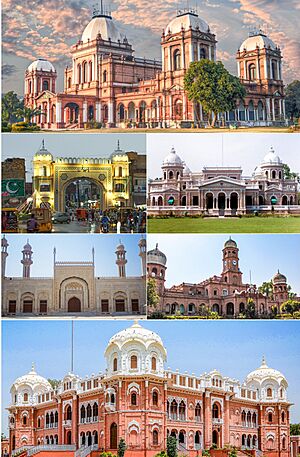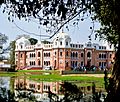Bahawalpur facts for kids
Quick facts for kids
Bahawalpur
بہاول پور
|
|
|---|---|
|
Metropolis
|
|

Clockwise from top: Noor Mahal Palace, Gulzar Mahal, Sadiq Dane High School, Darbar Mahal Palace, Sadiq Mosque, Fareed Gate
|
|
| Nickname(s):
City of Palaces
|
|
|
Location in Punjab, Pakistan
|
|
| Country | |
| Province | Punjab |
| Division | Bahawalpur |
| District | Bahawalpur |
| Union councils | 21 |
| Government | |
| • Type | Metropolitan Corporation |
| Area | |
| • City | 246 km2 (95 sq mi) |
| • Metro | 24,830 km2 (9,590 sq mi) |
| Elevation | 118 m (387 ft) |
| Population
(2017)
|
|
| • City | 762,111 |
| • Density | 3,098/km2 (8,024/sq mi) |
| Time zone | UTC+5 (PKT) |
| Postal code type |
63100
|
| Area code(s) | 062 |
| Website | Bahawalpur / Punjab Portal |
Bahawalpur is a large city in Punjab, Pakistan. It is one of the biggest cities in Pakistan. It is also the 6th most populated city in the Punjab province. Bahawalpur is the main city of the Bahawalpur Division.
This city was started in 1748 by the Daudpotra family from Sindh. Bahawalpur used to be the capital of the princely state of Bahawalpur. This state was ruled by leaders called Nawabs of Bahawalpur until 1955. The Nawabs built many beautiful buildings. Because of this, Bahawalpur is known for its amazing old palaces and monuments. The city is located near the Cholistan Desert. It is also a gateway to the nearby Lal Suhanra National Park.
Contents
History of Bahawalpur
Bahawalpur was one of the many princely states before India and Pakistan became separate countries.
How Bahawalpur Started
The Bahawalpur area has been home to many old societies. It has ruins from the Indus Valley civilisation. It also has ancient Buddhist sites like Patan minara. The region was once part of the Multan province of the Mughal Empire. Before Bahawalpur was built, Uch Sharif was a major city in the Cholistan region. It was a big center between the 12th and 17th centuries. Uch Sharif is famous for its old shrines dedicated to Muslim mystics.
Bahawalpur was founded in 1748 by Nawab Bahawal Khan I. He moved to the area from Shikarpur, Sindh. Bahawalpur became the new capital city for his family, replacing Derawar. The city grew quickly as a trading spot. It was on the important trade routes between Afghanistan and central India.
Attacks and Treaties
In 1785, a commander from the Durrani Empire attacked Bahawalpur. He destroyed many buildings. The ruling family of Bahawalpur had to hide in the Derawar Fort. They successfully fought off more attacks there.
Later, in 1807, Ranjit Singh of the Sikh Empire attacked the fort in Multan. Many people sought safety in Bahawalpur. The Nawab of Bahawalpur signed a treaty with the British in 1833. This treaty made sure Bahawalpur stayed independent. It also helped the British during their invasion of the Sikh Empire.
Trade and British Influence
By the 1830s, trade routes changed. British visitors saw many empty shops in Bahawalpur's market. The city's population was about 20,000 people. Most of them were Hindus. In 1833, the Sutlej and Indus Rivers were opened for boats. This allowed goods to reach Bahawalpur. By 1845, new trade routes to Delhi helped Bahawalpur become a trading center again.
In the late 1800s, the city was known for making silk goods, lungis, and cotton items. The silk from Bahawalpur was even better than silk from other famous cities. In 1866, a problem with who would rule Bahawalpur led to more British influence. Bahawalpur became a municipality in 1874.
Joining Pakistan
After the British left the Sub-Continent in 1947, princely states could join Pakistan or India. Bahawalpur and its princely state joined Pakistan on October 7, 1947. This was done under Nawab Sadiq Muhammad Khan Abbasi V Bahadur. After this, many Hindu and Sikh people moved to India. Muslim refugees from India came to live in Bahawalpur.
Modern Times
A notable event in modern Bahawalpur was an aircraft crash in 1988. Muhammad Zia-ul-Haq, who was the president of Pakistan, died in this crash.
City Information
Bahawalpur is divided into 6 smaller areas called tehsils. It has 109 local councils and 714 villages.
Climate
Bahawalpur is about 117 meters (387 feet) above sea level. The climate is dry. It is classified as semi-arid, which means it's hot and dry. The city gets about 289 millimeters (11 inches) of rain each year. The average yearly temperature is about 25.7°C (78.3°F).
Plants and Animals
Bahawalpur is home to various plants and animals.
Plants
- Kikar
- Shisham
- Sufaida
- Neem
- Siris
- Toot
- Sohanjana
Animals
Economy
The main crops grown in Bahawalpur are cotton, sugarcane, wheat, and rice. Bahawalpur is also known for its fruits. These include mangoes, citrus fruits, dates, and guavas. Some of these fruits are sent to other countries. Vegetables like onions, tomatoes, and potatoes are also grown.
Bahawalpur is becoming an industrial city. Industries like cotton processing, flour mills, and textile weaving are growing. Sheep and cattle are raised for wool and hides.
Crafts
Bahawalpur is famous for its beautiful carpets, embroidery, and pottery. The government has a Craft Development Centre. Here, you can buy handicrafts. Most of these crafts are made in the Cholistan area. Some popular items include:
- Flassi: This is made from camel hair. It can be used as a carpet or hung on a wall.
- Gindi: This is a colorful cotton cloth with fine needlework. It can be a blanket, carpet, or bed cover.
- Changaries: These are made from palm leaves. They can be used as wall decorations or to hold bread.
- Khalti: This is a type of purse with colorful threadwork.
- Artwork: Special traditional embroidery is done on clothes like kurta and chaddar (shawl).
People of Bahawalpur
In 2017, the city's population was 762,111 people. Most residents are Muslims. There are also smaller groups of Hindus and Christians.
City Buildings and Services
Bahawalpur is improving its security. The city is installing many CCTV cameras. This will help keep everyone safe.
Important Buildings
- The city's beautiful Noor Mahal palace was finished in 1875.
- The Empress Bridge was built in 1878. It was the first railway bridge over the Sutlej River.
- Two hospitals were opened in the city in 1898. One of them was the Bahawal Victoria Hospital.
- The Darbar Mahal was built in 1905.
- The Gulzar Mahal was built in 1909.
Bahawalpur Museum
The Bahawalpur Museum opened in 1976. It shows the history, art, and culture of the region. It has eight different sections, called galleries. These include:
- A gallery about the Pakistan Movement.
- An archaeological gallery with old artifacts.
- An Islamic gallery with old writings and Quranic documents.
- A cultural heritage gallery.
- An art gallery.
- A coins gallery.
- A gallery about the Cholistan Desert.
- A gallery honoring Nawab Bahawal.
Bahawalpur Zoo
The Bahawalpur Zoo was started in 1942. It is a large zoo, covering 25 acres. The zoo sometimes breeds and provides wild cats, like Asiatic lions and Bengal tigers, to other zoos. It also has an aquarium and a museum with stuffed animals. Bahawalpur Zoo is the fourth largest zoo in Pakistan.
Railway Station
The Bahawalpur Railway Station is an important train station. It connects Bahawalpur to many major cities in Pakistan. These include Karachi, Lahore, Rawalpindi, and Peshawar. The station has offices for booking tickets. Plans are in place to make it a modern railway station.
Lal Suhanra National Park
Lal Suhanra National Park is a large national park in Pakistan. It is about 35 kilometers east of Bahawalpur. It is one of South Asia's biggest national parks. UNESCO has named it a Biosphere Reserve. Lal Suhanra is special because it has different types of land. These include desert, forest, and wetlands.
Education
Bahawalpur has a strong focus on education. Sadiq Egerton College was founded in 1886. The first university, Islamia University, started in 1925. The city's Quaid-e-Azam Medical College was founded in 1971. The district has a literacy rate of 48%. There are 1662 schools and 24 colleges.
Transportation
People in Bahawalpur use buses, cars, motorbikes, and rickshaws to get around.
Highways
Pakistan's longest national highway, N-5, goes through Bahawalpur. This highway connects Bahawalpur to Karachi in the south and Lahore in the north.
Railroad
The railway system links Bahawalpur to many cities. These include Karachi, Lahore, Rawalpindi, and Peshawar.
Sports
Bahawal Stadium is a multi-purpose stadium in the city. It once hosted an international cricket match between Pakistan and India in 1955. The Motiullah hockey stadium is also part of Bahawal Stadium. It hosts national and international hockey games. The stadium also has a gym and a swimming pool for people to use. There are tennis courts and a 2-kilometer jogging track around the football ground.
Notable People
- Ehtisham Khan, a film and television actor.
- Samiullah Khan, a former field hockey player.
- Durdana Ansari, a former journalist and producer at the BBC World Service.
- Muhammad Adil, a Pakistani footballer.
- Nawab Salahuddin Abbasi, a former Member of the National Assembly of Pakistan.
- Samiullah Chaudhary, a Member of the Provincial Assembly of the Punjab.
- Ch.Tariq Bashir Cheema, a former member of the National Assembly of Pakistan.
- Muhammad Zubair Saleem, a Disabled Cricket Team Player.
- Saqib Sameer, a television and theater actor and writer.
- Muhammad Farooq Azam Malik, a Member of National Assembly of Pakistan.
- Mastana – Murtaza Hassan, a Pakistani comedian and stage actor.
- Usman Tariq, a first-class Pakistani cricketer.
Images for kids
See also
 In Spanish: Bahawalpur para niños
In Spanish: Bahawalpur para niños












